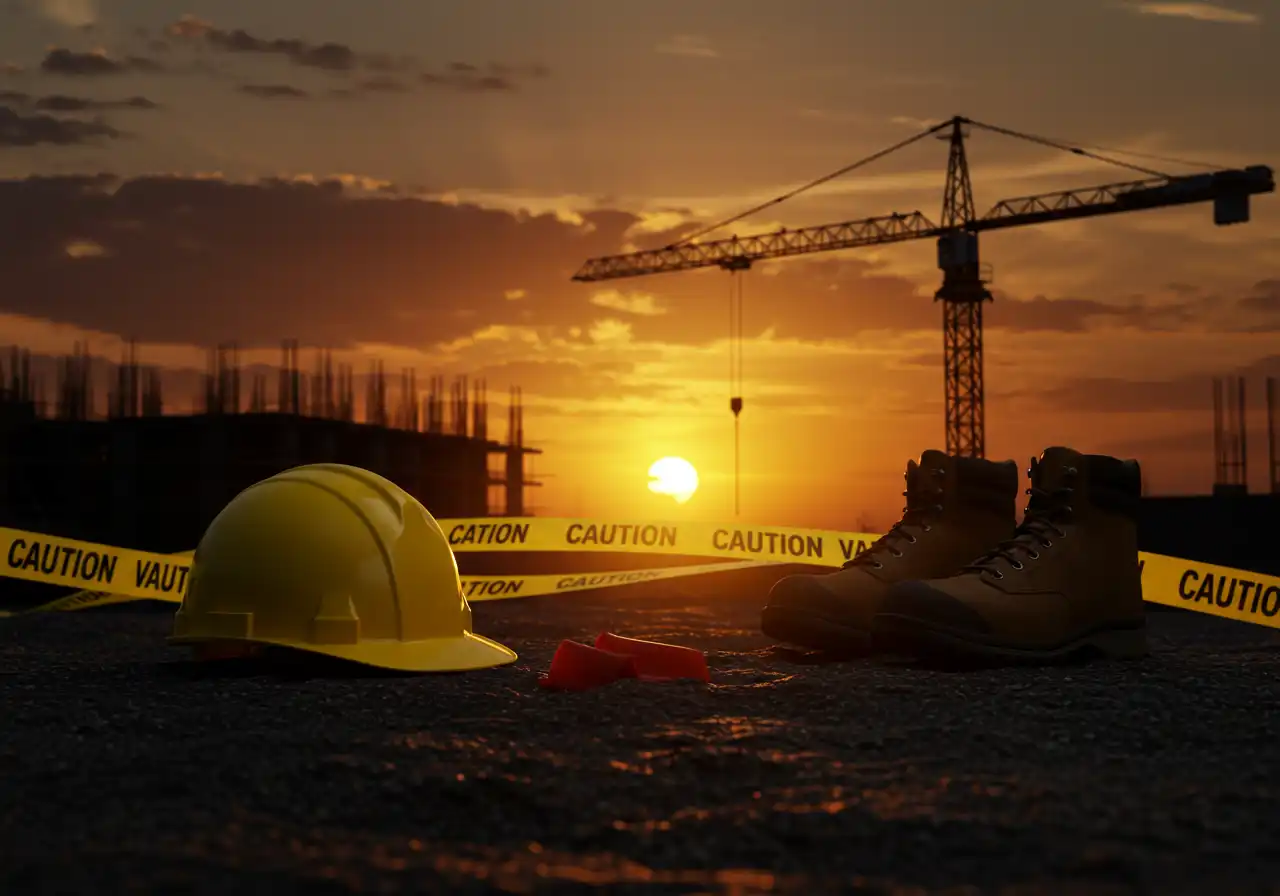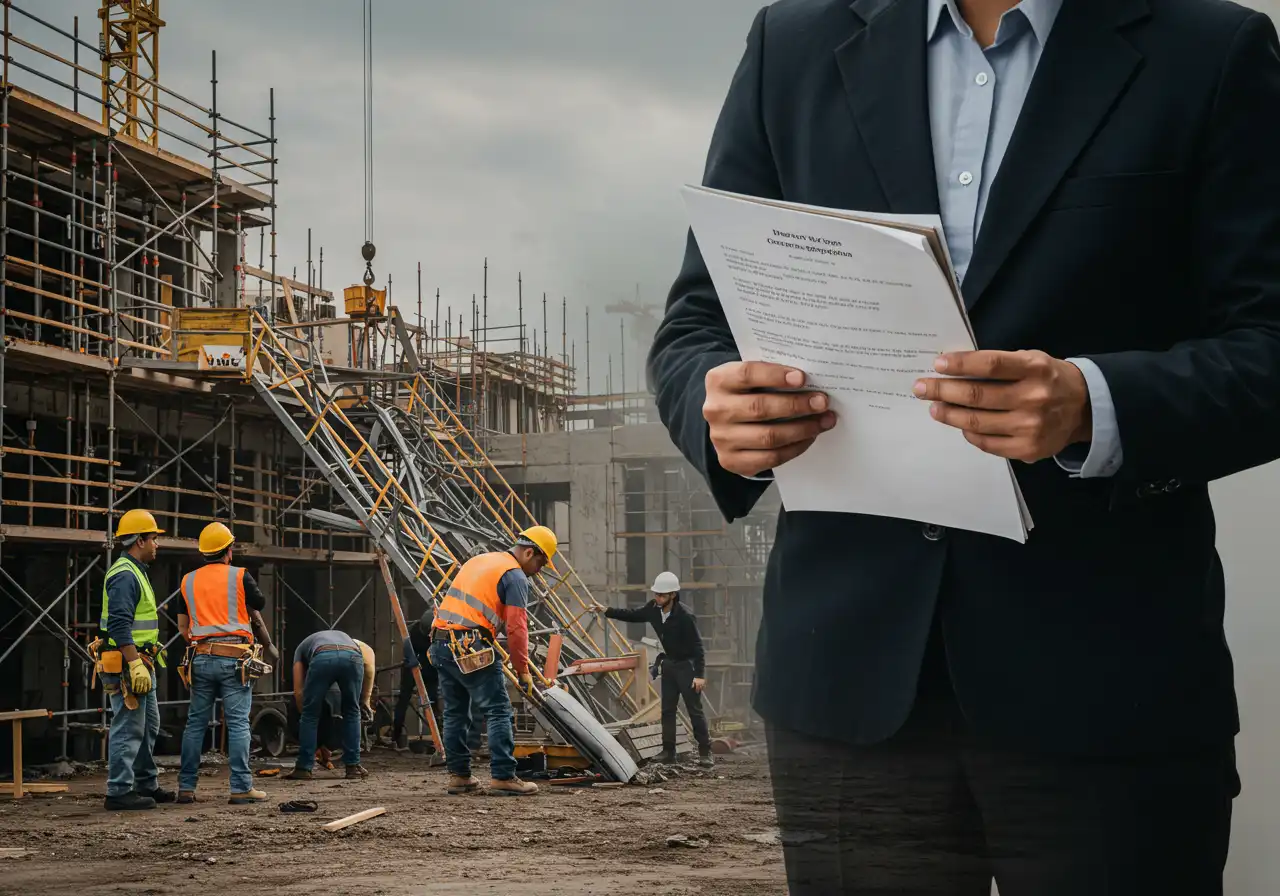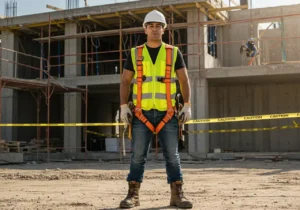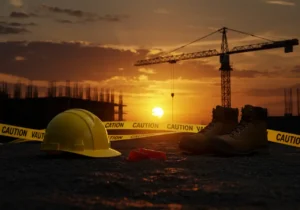Construction sites are one of the most dangerous places to work, with construction accidents causing many workplace injuries and deaths every year. The nature of building, tearing down, and renovating structures puts workers at risk for various dangers, such as falling or getting electrocuted. These accidents lead to physical injuries, lost work time, higher insurance costs, and emotional pain for families and co-workers.
It’s essential for anyone involved in construction projects—whether as a worker or manager—to understand the main reasons behind these accidents and how to stop them. By knowing where the risks come from, you can put specific safety measures in place that truly protect your team. Site managers, workers, and safety coordinators all have important roles in spotting dangers before they cause harm.
This article will discuss:
- The primary factors that cause accidents on construction sites
- Real-life examples that demonstrate these risks
- Effective methods that have been proven to lower these risks
By highlighting common hazards and offering practical ways to prevent them, this guide hopes to promote a culture of safety in construction—ensuring your team’s well-being while still achieving project objectives.
Understanding Construction Accident Statistics
Construction remains one of the most hazardous industries in the United States. According to the Bureau of Labor Statistics, construction accounted for 1,008 workplace fatalities in 2021, making it responsible for nearly one out of every five work-related deaths. These construction accident statistics highlight an urgent need for rigorous safety protocols on every site.
A deeper look into these numbers reveals that not all accidents are created equal. The Occupational Safety and Health Administration (OSHA) identifies the “Fatal Four” as the leading causes of death in construction:
- Falls are responsible for 37% of construction fatalities.
- Struck-by Incidents account for approximately 8% of deaths.
- Electrocutions cause about 8% of fatalities.
- Caught-in or Caught-between hazards represent nearly 5% of all construction deaths.
Eliminating these four types of accidents would save hundreds of lives each year.
Understanding these patterns is critical. Each category points to specific activities and hazards inherent to construction work, from elevated tasks to working near heavy equipment and live electrical circuits. Recognizing where risks concentrate gives you a foundation for targeted prevention strategies—a core focus throughout this article.
1. Falls: The Leading Cause of Construction Accidents
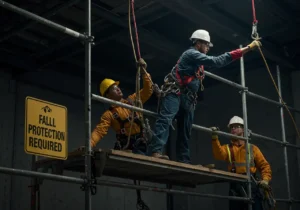 Falls in construction consistently rank as the most frequent and deadly hazard on job sites, responsible for about 37% of all construction fatalities each year. The high rate is not surprising if you look at the typical environments and work activities involved in the industry. Anytime workers operate at heights or navigate uneven surfaces, the risks increase significantly.
Falls in construction consistently rank as the most frequent and deadly hazard on job sites, responsible for about 37% of all construction fatalities each year. The high rate is not surprising if you look at the typical environments and work activities involved in the industry. Anytime workers operate at heights or navigate uneven surfaces, the risks increase significantly.
Why So Many Falls Happen
Construction sites are full of potential fall hazards, including:
- Elevated work platforms: Roofs, beams, open-sided floors, and mezzanines force workers to operate many feet above ground level.
- Ladders: Improper use, unstable positioning, or faulty equipment can turn a routine climb into a life-threatening incident.
- Scaffolding: Incomplete assembly, defective parts, or missing guardrails can create dangerous gaps or collapse risks.
- Unprotected edges and floor openings: Unmarked holes and exposed perimeters are common on unfinished structures.
A moment’s distraction or a single unsecured opening is enough to cause tragedy.
OSHA Fall Protection Standards
The Occupational Safety and Health Administration (OSHA) sets strict requirements around fall protection systems. According to their standards:
Any time a construction worker is exposed to a vertical drop of six feet or more, employers must provide a form of fall protection.
This rule applies whether you’re working on rooftops, scaffolds, ladders above six feet, or even inside buildings with open shafts or stairwells.
Required Fall Protection Devices
OSHA recognizes several types of fall protection devices for different situations:
- Guardrail systems: Physical barriers installed at the edge of elevated surfaces.
- Safety net systems: Nets placed below work areas to catch falling workers or debris.
- Personal fall arrest systems (PFAS): Harnesses worn by workers that connect to secure anchor points via lanyards or lifelines.
- Hole covers and toe boards: These are used to cover floor openings and prevent tools from falling off ledges.
Each device suits specific tasks—roofing may rely heavily on PFAS and guardrails, while framing operations might need safety nets beneath.
Best Practices for Fall Arrest Equipment
Preventing falls in construction starts with proper installation and consistent use of equipment.
- Inspect harnesses and lanyards daily for wear, fraying, broken stitching, or damage.
- Anchor points must support at least 5,000 pounds per worker attached, as specified by OSHA guidelines.
- Train every worker on how to properly don harnesses and connect lifelines before starting any job at height.
- Never bypass safety devices—guardrails should never be removed for convenience.
- Keep walkways clear so tripping hazards don’t contribute to loss of balance near edges.
Misuse or neglect of even a single piece of fall protection gear can lead to disastrous results.
Reducing falls in construction requires diligent attention to detail and unwavering commitment from every crewmember on site. When everyone understands the stakes—and uses fall protection systems by the book—the odds shift dramatically in favor of safety.
2. Struck-by Incidents: Risks from Moving Objects and Equipment
Struck-by accidents are a significant source of hazards on construction sites, making up about 8% of all construction deaths each year. These incidents occur when workers are hit by objects, vehicles, or heavy equipment—a risk that is always present in busy job sites.
Common Struck-By Hazards
Several situations often lead to struck-by injuries or fatalities:
- Falling Tools or Materials: Tools dropped from ladders, scaffolding, or elevated platforms can cause serious head and body injuries. Even a small wrench, when dropped from a height, becomes a deadly projectile.
- Moving Vehicles: Dump trucks, forklifts, and other vehicles have large blind spots and often operate in tight spaces. Workers on foot may be run over or pinned if proper precautions aren’t taken.
- Heavy Machinery Operations: Cranes swing loads overhead, excavators rotate without warning, and backhoes shift unexpectedly, all creating unpredictable movement zones.
Site congestion and poor communication only increase the risks. Keeping everyone aware of active equipment—especially in noisy environments—is crucial for maintaining safety.
Organizing the Job Site for Safety
Effective site organization is one of the most practical ways to reduce struck-by accidents:
- Establish clear pathways for both workers and vehicles. Mark walkways with bright paint or physical barriers so foot traffic never crosses into machinery paths.
- Erect barricades around active work zones where heavy lifting or machine operation is taking place. Barriers should be sturdy enough to prevent accidental entry but easy to see from a distance.
- Store tools and materials securely at height using tool lanyards and toe boards on scaffolds to keep objects from falling.
Communication and Hazard Awareness
Constant communication between operators and ground personnel is vital:
- Assign trained spotters equipped with high-visibility vests to guide vehicle movements near blind spots or pedestrian areas.
- Use standardized hand signals or two-way radios during complex maneuvers.
- Post visible warning signs in multiple languages if your workforce is multilingual.
“Every person on site should know exactly where equipment will move next—and how to get out of its way.”
Audible alarms, flashing lights on machines, and dedicated crossing points reinforce these messages every day.
Prioritizing awareness, organization, and clear lines of communication significantly reduces the risk of struck-by incidents—a step every project manager can take when addressing the top causes of construction accidents and how to prevent them. Site leaders who emphasize these basics create safer environments where equipment safety isn’t just a checklist item but an embedded part of daily operations.
3. Electrocutions: Electrical Hazards on Construction Sites
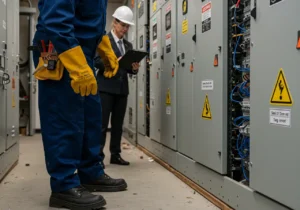 Electrocution remains a critical threat on construction sites, accounting for approximately 8% of industry fatalities each year. The risk is ever-present, especially where electrical systems are being installed, maintained, or repaired. Most incidents stem from contact with exposed wiring, defective power tools, or mishandling live circuits.
Electrocution remains a critical threat on construction sites, accounting for approximately 8% of industry fatalities each year. The risk is ever-present, especially where electrical systems are being installed, maintained, or repaired. Most incidents stem from contact with exposed wiring, defective power tools, or mishandling live circuits.
Common sources of electrical hazards include:
- Exposed wiring left unsecured or unmarked
- Improper use of extension cords, often overloaded or run through water
- Damaged tools, such as frayed cords or broken plugs
- Lack of ground-fault circuit interrupters (GFCIs) in wet environments
- Failure to de-energize circuits before work begins
Electrocution prevention measures start with rigorous adherence to safety protocols:
- Regular Inspection: All electrical equipment and wiring should be checked daily for visible damage.
- Lockout/Tagout Procedures: Proper procedures must be followed before servicing equipment to ensure no accidental energization.
- Personal Protective Equipment (PPE): Insulated gloves and boots are non-negotiable when handling live electricity.
- Electrical Safety Training: Workers must understand safe practices—including keeping a safe distance from overhead power lines and never bypassing circuit protection devices.
Strong emphasis on electrical safety in construction sites can mean the difference between routine work and life-altering accidents. Strict compliance with OSHA electrical standards is essential across all job sites.
4. Caught-in or Caught-between Hazards: Crushing Risks on Sites
Caught-in or caught-between hazards account for approximately 5% of all construction fatalities, making them a significant threat to worker safety. These incidents occur when workers are pinched, compressed, or crushed between objects, equipment, or collapsing materials.
Common examples include:
- Being trapped between a moving vehicle and a stationary object
- Getting caught in unguarded machinery or tools
- Collapse of trench walls during excavation work
- Workers pinned by shifting loads or falling structural elements
Caught-in-between accidents prevention measures focus on eliminating the risk of entrapment through practical site management and strict adherence to safety protocols:
- Always use machine guards and lockout/tagout procedures when servicing equipment
- Never work in unprotected trenches deeper than five feet without proper shoring or shielding
- Keep clear communication with heavy equipment operators; never assume they can see you
- Store materials securely to prevent collapse, and inspect scaffolding or temporary structures daily
Proper planning and daily hazard assessments are essential for identifying areas where workers might be at risk. When teams prioritize these controls, the chance of fatal entrapment drops significantly. Site leaders who consistently enforce caught-in-between accidents prevention measures help create a safer environment for every crew member.
Additional Common Causes Beyond the Fatal Four And How To Prevent Them
Construction safety risks extend beyond OSHA’s Fatal Four. Several contributing factors often fly under the radar but lead to preventable injuries and property damage every year. Addressing these issues is essential for any site aiming to reduce its accident rate and create a culture of safety.
Hazard Communication Training Deficiencies in Construction Sites
A significant number of accidents occur because workers are unaware of onsite dangers. When hazard communication breaks down, the results can be catastrophic.
- Lack of clear signage and labeling makes it easy for employees to walk into restricted areas or mishandle hazardous materials.
- Inadequate or rushed safety briefings leave workers guessing about new hazards introduced by shifting project phases or subcontractors.
- Language barriers and insufficient training materials contribute to misunderstandings, especially on multicultural crews.
Regular hazard communication training ensures everyone understands material safety data sheets (SDS), knows how to read warning labels, and is aware of all current site hazards. Toolbox talks conducted at the start of each shift keep critical information top-of-mind.
Improper Use and Maintenance of Ladders and Scaffolding
Ladder-related accidents rank among the most frequent non-fatal injuries on construction sites.
These incidents often result from:
- Selecting the wrong type or size of ladder for a task
- Overloading ladders past their weight limit
- Using damaged or worn-out equipment
- Failing to secure ladders or scaffolding properly before use
Routine inspections are vital. Supervisors should ensure all ladders and scaffolding meet OSHA standards before work begins. Workers must be trained not only to recognize faulty equipment but also in proper setup techniques—such as maintaining three points of contact when climbing and never overreaching.
Respiratory Protection and PPE Shortcomings
Dust, fumes, silica, asbestos, and other airborne contaminants pose serious long-term health threats if respiratory protection is neglected.
Many sites fall short by:
- Failing to provide adequate personal protective equipment (PPE) for every worker exposed to harmful particles
- Skipping fit testing for respirators, which can render even high-quality gear ineffective
- Allowing PPE policies to lapse during “quick” jobs or when supervisors aren’t present
Proper respiratory protection includes issuing N95 masks, half-face or full-face respirators, depending on the hazard level, and enforcing their use whenever dust-generating tasks are underway. PPE access must also cover gloves, goggles, hearing protection, and high-visibility clothing where needed.
“When you invest in clear communication, reliable gear, and practical training, you’re not just following regulations—you’re saving lives.”
These common issues—hazard communication failures, improper ladder use, and PPE lapses—underscore why ongoing vigilance is key in reducing accidents. The next step involves embedding these lessons into your company’s training programs and daily routines to sustain a safer workplace.
Strengthening Training Programs And Safety Culture To Prevent Construction Accidents
Comprehensive construction safety training programs lay the groundwork for reducing risks on every jobsite. You can see a direct link between well-structured training and fewer accidents, especially when sessions are tailored to site-specific hazards and regularly updated as regulations or equipment change.
Regular Mandatory Training Sessions
- OSHA compliance training should be mandatory for all new hires and repeated annually.
- High-impact topics include fall prevention, hazard communication, proper use of PPE, lockout/tagout procedures, and equipment operation.
- Toolbox talks before shifts keep safety protocols fresh in everyone’s mind.
- Site-specific drills—such as simulated emergency evacuations or equipment failure scenarios—prepare teams for real-life incidents.
Training isn’t just about ticking boxes. When you use plain language, hands-on demonstrations, and address language barriers, everyone gets the information they need to stay safe. Interactive sessions—where workers handle equipment or practice rescue techniques—lead to higher retention than lectures alone.
Fostering a Proactive Safety Mindset
A strong safety culture goes beyond compliance. Workers must feel personally responsible for each other’s safety and empowered to speak up.
- Encourage near-miss reporting without fear of punishment. These reports help identify risks before someone is injured.
- Recognize and reward proactive behavior, such as stopping unsafe practices or suggesting workplace safety improvements.
- Appoint safety champions or mentors who model best practices and coach their peers.
- Management should lead by example, consistently wearing PPE and participating in all training sessions alongside crews.
“Safety isn’t a one-time event; it’s a daily commitment shared by everyone onsite.”
True worker engagement comes from open dialogue. Listen to concerns about broken equipment, unclear signage, or time pressures that tempt shortcuts. Address issues quickly so trust grows and standards rise.
The Top Causes of Construction Accidents and How to Prevent Them are well-documented—and so are the solutions. By investing in construction safety training programs, prioritizing OSHA compliance training, and nurturing a proactive mindset across your team, you create an environment where preventing construction accidents becomes second nature instead of an afterthought.
Stay vigilant. Review your site protocols often. Make every worker part of the solution. Adherence to OSHA regulations isn’t just a legal requirement—it’s the foundation for sending everyone home safe at the end of every shift.
Take action today:
Commit to ongoing safety vigilance and empower your crew with the knowledge and confidence they need to prevent construction accidents—before they happen.

